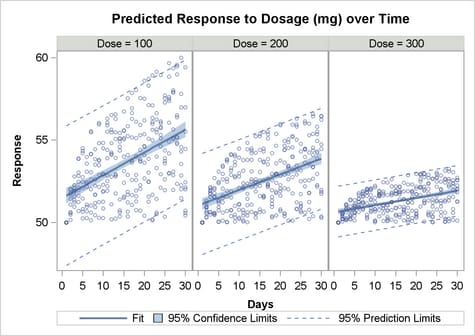Using Non-computed Plots in Classification Panels
So far
the discussion has focused on how to set up the grid and axes of the
panel using simple prototype examples. However, complex prototype
plots can also be specified, although BARCHART is the only computed
plot that can be used in the prototype. The restriction of using only
non-computed plots in the prototype is mitigated by the fact that
most computed plot types are available in a non-computed (parameterized)
version—BOXPLOTPARM, ELLIPSEPARM, and HISTOGRAMPARM. Also,
the fit line statements (REGRESSIONPLOT, LOESSPLOT, or PBSPLINEPLOT)
can be emulated with a SERIESPLOT, and the MODELBAND statement can
be emulated with a more general BANDPLOT statement, provided the appropriate
variables have been created in the input data. Many SAS/STAT and SAS/ETS
procedures can create output data sets with this information.
The following
example uses PROC GLM to create an output data set that is suitable
for showing a panel of scatter plots with overlaid fit lines and confidence
bands.
proc template;
define statgraph dosepanel;
begingraph / designwidth=490px designheight=350px;
layout datapanel classvars=(dose) / rows=1;
layout prototype;
bandplot x=days limitupper=uclm limitlower=lclm / name="clm"
display=(fill) fillattrs=GraphConfidence
legendlabel="95% Confidence Limits";
bandplot x=days limitupper=ucl limitlower=lcl / name="cli"
display=(outline) outlineattrs=GraphPredictionLimits
legendlabel="95% Prediction Limits";
seriesplot x=days y=predicted / name="reg"
lineattrs=graphFit legendlabel="Fit";
scatterplot x=days y=response / primary=true
markerattrs=(size=5px) datatransparency=.5;
endlayout;
sidebar / align=top;
entry "Predicted Response to Dosage (mg) over Time" /
textattrs=GraphTitleText pad=(bottom=10px);
endsidebar;
sidebar / align=bottom;
discretelegend "reg" "clm" "cli" / across=3;
endsidebar;
endlayout;
endgraph;
end;
run;
The following
procedure code creates the required input data set for the template.
It uses a BY statement with the procedure to request the same classification
variable that is used in the panel.
data trial;
do Dose = 100 to 300 by 100;
do Days=1 to 30;
do Subject=1 to 10;
Response=log(days)*(400-dose)* .01*ranuni(1) + 50;
output;
end;
end;
end;
run;
proc glm data=trial alpha=.05 noprint;
by dose;
model response=days / p cli clm;
output out=stats
lclm=lclm uclm=uclm
lcl=lcl ucl=ucl
predicted=predicted;
run; quit;
ods listing style=statistical;
proc sgrender data=stats template=dosepanel;
run;
